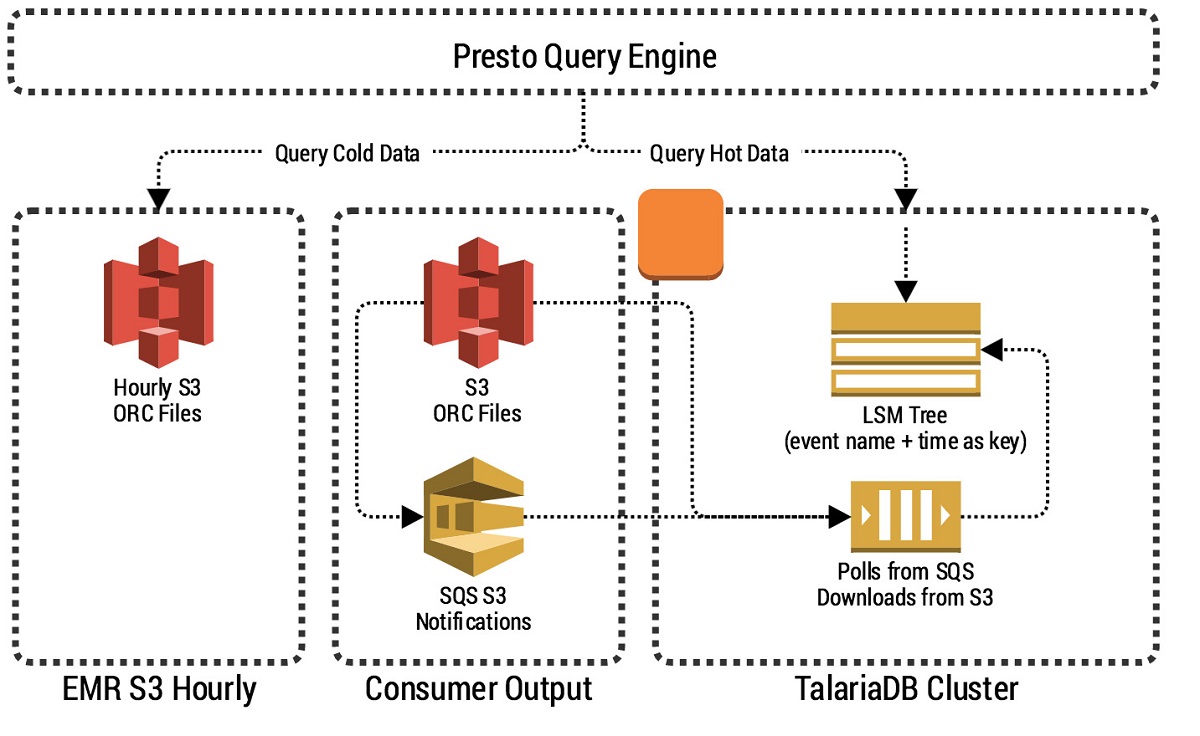Introduction
Presto is a cutting-edge open-source distributed SQL query engine designed for high-performance analytics on big data. It was developed by Facebook and has gained widespread adoption in the tech industry due to its speed, flexibility, and scalability. Presto allows users to analyze large datasets stored in various data sources, including Hadoop Distributed File System (HDFS), Apache Cassandra, and relational databases, in real-time.
With the exponential growth of data in recent years, businesses are constantly searching for ways to harness the power of big data to gain actionable insights and make data-driven decisions. Traditional big data tools often come with limitations that hinder agility and real-time analysis. However, Presto addresses these challenges by providing a lightning-fast SQL querying engine that can traverse vast amounts of data within seconds.
One of the key advantages of Presto is its ability to perform federated queries, allowing users to join and analyze data from different sources seamlessly. Whether it’s querying data from a data warehouse, searching for patterns in log files, or performing interactive analytics, Presto provides a unified solution that eliminates the need for multiple specialized tools.
In this article, we will explore the history of Presto, its key features, how it works, and discuss the differences between Presto and other big data tools. We will also delve into the various use cases where Presto shines and highlight its advantages and limitations. By the end, you’ll have a comprehensive understanding of why Presto is revolutionizing the world of big data analytics.
What is Presto?
Presto is an open-source distributed SQL query engine designed to handle the challenges of big data analytics. It allows users to query and analyze large datasets quickly and efficiently, making it a valuable tool for organizations working with massive amounts of data.
Presto is known for its high performance, scalability, and flexibility. It can seamlessly integrate with various data sources, including traditional relational databases, Hadoop Distributed File System (HDFS), and NoSQL databases like Apache Cassandra. This versatility enables users to access and analyze data from different sources using a single interface, eliminating the need to learn and use multiple tools.
One of the key features of Presto is its ability to execute federated queries. This means that it can combine data from multiple sources and provide a unified view for analysis. For example, you could run a query that joins data from a relational database with log files stored in Hadoop, allowing you to gain insights from both structured and unstructured data.
Presto is designed to be highly scalable, allowing it to handle large datasets efficiently. It achieves this by dividing queries into smaller tasks that are distributed across a cluster of machines. This distributed architecture ensures faster processing and optimal resource utilization, enabling users to analyze massive amounts of data in real-time.
Another notable feature of Presto is its support for ANSI SQL, a widely used standard for querying relational databases. This means that users familiar with SQL can easily write and execute queries in Presto, without the need to learn a new query language. Additionally, Presto provides advanced SQL features such as functions, joins, aggregations, and subqueries, making it a powerful tool for complex data analysis.
Presto’s architecture follows a loosely coupled design, where computation and storage layers are decoupled. This allows organizations to use Presto alongside their existing data storage systems, without the need to migrate or replicate data. Furthermore, Presto supports a wide range of data formats, including Avro, Parquet, JSON, and CSV, making it compatible with diverse data sources.
In summary, Presto is a versatile and powerful distributed SQL query engine that enables organizations to query and analyze large datasets efficiently. Its support for federated queries, scalability, and compatibility with various data sources make it a popular choice for big data analytics.
History of Presto
Presto was initially developed by Facebook to address the challenges they faced when analyzing massive amounts of data in their social media platform. The need for a fast and efficient query engine led Facebook engineers to create Presto as an open-source project in 2012.
At its core, Presto was designed to be a distributed SQL query engine capable of handling petabytes of data. It was built with a focus on speed, allowing Facebook to perform real-time analytics on their vast data sets.
After its successful implementation at Facebook, Presto gained widespread attention in the tech community. In 2013, Facebook open-sourced Presto, making it available to the broader public. This move led to a growing community of developers and organizations contributing to and adopting Presto for their own big data analytics needs.
Since its inception, Presto has undergone significant development and improvements. In 2014, the Presto Software Foundation was established to provide governance and guidance for the project’s growth. The foundation ensures that Presto remains an open-source project, driven by the collaborative efforts of the community.
One of the key milestones in Presto’s history was the integration with popular big data tools and platforms. Presto became compatible with Apache Hive, allowing users to leverage existing Hive metadata and query data stored in Hive tables. This integration enhanced Presto’s adoption and provided users with a wider range of data sources to analyze.
Over the years, Presto’s community has grown significantly, with contributions from major tech companies, such as Netflix, Airbnb, and LinkedIn. These contributions have led to continuous improvements in functionality, performance, and compatibility, making Presto a powerful tool in the big data analytics landscape.
Since its initial release, Presto has evolved into a mature and robust query engine, capable of handling complex analytical workloads in various industries. Its versatility and scalability have made it a popular choice for organizations dealing with massive data sets, seeking to extract valuable insights efficiently.
As Presto continues to evolve, its community remains dedicated to enhancing its capabilities and addressing the ever-growing needs of big data analytics. With ongoing development and support, Presto is poised to remain a leading solution for real-time analytics in the world of big data.
Key Features of Presto
Presto offers a wide range of features that make it a powerful and versatile tool for big data analytics. These features contribute to its popularity and adoption in various industries. Let’s explore some of the key features of Presto:
High Performance: Presto is designed for speed. It achieves this by executing queries in parallel across a distributed cluster of machines. This architecture allows for efficient processing of large datasets, providing real-time analysis capabilities.
Federated Queries: Presto enables users to query and analyze data from multiple sources simultaneously. Whether it’s accessing data from relational databases, Hadoop clusters, or cloud-based storage, Presto can seamlessly join and analyze data from different sources, providing a unified view for analysis.
Compatibility: Presto supports a wide range of data sources and formats. It can connect to popular databases like MySQL, PostgreSQL, and Oracle, as well as various file formats such as Parquet, Avro, and JSON. This compatibility allows organizations to leverage their existing data infrastructure without the need for data replication.
ANSI SQL Support: Presto supports ANSI SQL, a widely used standard for querying relational databases. This means that users familiar with SQL can easily write and execute queries in Presto, reducing the learning curve associated with new query languages. Moreover, Presto provides advanced SQL features like subqueries, joins, and window functions, enabling complex data analysis.
Scalability: Presto’s distributed architecture allows it to scale efficiently. As the size of the dataset grows, Presto can add more worker nodes to the cluster and distribute the workload, ensuring optimal resource utilization and faster query execution.
Flexibility: Presto’s flexibility lies in its ability to query structured and unstructured data seamlessly. It can handle various data types and formats, empowering organizations to perform diverse analysis tasks on data stored in different systems.
Data Security and Governance: Presto provides security features like authentication, authorization, and encryption to ensure data privacy and compliance. It integrates with external authentication systems, such as LDAP, Kerberos, and AWS Identity and Access Management (IAM), allowing organizations to enforce access controls and maintain data governance.
Community Support: Presto boasts a thriving community of developers and users who actively contribute to its development and share their knowledge. The active community support ensures regular updates, bug fixes, and enhancements, making Presto a reliable and well-supported tool for big data analytics.
These are just a few of the key features that make Presto a highly sought-after tool for big data analytics. Its performance, federated query capabilities, compatibility, scalability, and flexibility make it an ideal choice for organizations looking to extract insights and value from their data efficiently.
How Does Presto Work?
Presto operates on a distributed architecture to provide high-performance querying and analysis of large datasets. Understanding how Presto works can help us grasp its efficiency and scalability. Let’s delve into the inner workings of Presto:
Coordinator and Workers: The Presto cluster consists of a coordinator node and multiple worker nodes. The coordinator is responsible for receiving and parsing queries, optimizing query execution plans, and coordinating the execution across the worker nodes. The workers perform the actual processing of data and execute the query tasks assigned by the coordinator.
Query Parsing and Optimization: When a query is submitted to Presto, the coordinator parses the query and generates an execution plan. This plan outlines the steps and resources needed to execute the query efficiently. Presto optimizes the plan based on various factors, such as data distribution, join order, and data filtering, to minimize data movement and maximize performance.
Query Distribution and Execution: Once the optimization is complete, the coordinator divides the query into smaller tasks and distributes them to the worker nodes. These tasks are executed in parallel across the worker nodes, operating on subsets of the data. The workers process the tasks simultaneously, and each worker returns the partial results to the coordinator.
Result Aggregation: As the worker nodes complete their tasks, the coordinator collects the partial results and aggregates them to produce the final result. The result aggregation ensures that the output of the query is consolidated and presented to the user as a unified dataset. This real-time aggregation contributes to Presto’s ability to provide interactive query responses.
Data Localization and Storage Integration: Presto leverages the concept of data localization to improve query performance. It tries to execute tasks on worker nodes where the data is already stored, reducing data movement across the cluster. Presto can also integrate with various data storage systems, allowing users to query data directly from these sources without having to move or replicate the data.
Dynamic Resource Allocation: Presto supports dynamic resource allocation, allowing it to adapt to changing workloads and allocate resources efficiently. It can scale up or down the number of worker nodes based on demand, ensuring optimal performance and resource utilization. This flexibility makes Presto ideal for environments with fluctuating query workloads.
Connectivity to Data Sources: Presto provides connectors to various data sources, enabling seamless integration with external systems. These connectors allow users to query data from different sources, such as relational databases, Hadoop clusters, and cloud-based storage. Presto’s extensibility allows the addition of custom connectors to support specific data sources or formats.
Overall, Presto’s distributed architecture, query parsing and optimization, parallel query execution, and result aggregation enable it to deliver high-performance analytics on vast amounts of data. Its data localization capabilities, storage integration, and dynamic resource allocation further enhance its efficiency and scalability. By understanding how Presto works, users can harness its power to analyze and gain insights from big data in real-time.
Differences Between Presto and Other Big Data Tools
Presto stands out from other big data tools with its unique features and capabilities. Let’s explore some of the key differences between Presto and other popular big data tools:
Processing Speed: Presto is renowned for its lightning-fast query execution. Unlike traditional batch processing frameworks like Apache MapReduce, Presto operates in-memory and performs real-time analysis. This makes it ideal for interactive analytics and ad-hoc queries, delivering near-instant results.
Query Flexibility: Presto provides support for ANSI SQL, making it familiar and accessible to users already proficient in SQL. Other tools, like Apache Spark and Hive, may use their own query languages or dialects, which require additional learning and adaptation. Presto’s SQL compatibility allows for easy migration and integration into existing data analytics workflows.
Federated Data Access: One of the standout features of Presto is its ability to query and join data from multiple sources through federated queries. This means that Presto can access data residing in different systems, including traditional databases, data warehouses, and distributed file systems. In contrast, some other tools have limitations in terms of data source compatibility or require data to be replicated into a single system for analysis.
Data Format Support: Presto offers extensive support for various data formats, including Parquet, Avro, JSON, CSV, and more. This flexibility allows organizations to work with diverse data types and structures without the need for format conversion. In comparison, some other tools may have limited data format support or require data to be transformed into a specific format for processing.
Scalability: Presto’s distributed architecture enables it to scale horizontally, handling massive data volumes and increasing query throughput by adding more worker nodes to the cluster. This scalability is crucial for organizations dealing with exponential data growth. On the other hand, some other tools may have limitations in terms of scalability, requiring additional configurations or manual adjustments to handle large-scale data processing effectively.
Real-Time Analytics: Presto is designed for interactive analytics, allowing users to explore and query data in real-time. This makes it ideal for applications that require fast turnaround times, such as ad hoc data analysis, exploration, and data discovery. In contrast, other tools may be better suited for batch processing and offline analysis, trading query speed for other considerations such as fault tolerance or throughput.
Community and Ecosystem: Presto has a growing and vibrant community of developers and users contributing to its development and supporting its adoption. This active community ensures regular updates, bug fixes, and enhancements. Additionally, Presto integrates with various tools and platforms, such as Apache Hive and Apache Airflow, providing a rich ecosystem for data integration and workflow management. This thriving ecosystem contributes to Presto’s ease of use and extensibility.
These differences highlight some of the unique strengths of Presto compared to other big data tools. Its speed, SQL compatibility, federated data access, scalability, real-time analytics capabilities, and thriving community distinguish Presto as a powerful and versatile tool for modern big data analytics.
Use Cases for Presto
Presto’s versatility and high-performance querying capabilities make it an ideal choice for a wide range of use cases across industries. Let’s explore some of the key use cases where Presto excels:
Interactive Analytics: Presto’s ability to process queries in real-time makes it perfect for interactive analytics. It enables business analysts and data scientists to explore and analyze large datasets without having to wait for time-consuming batch processes. With Presto, users can obtain instant insights and make data-driven decisions faster.
Ad Hoc Queries and Data Exploration: Presto empowers users to run ad hoc queries on big data, enabling them to explore data on the fly and find valuable insights. Its fast query execution and support for ANSI SQL make it easy for users to ask complex questions and retrieve results in real-time. This makes Presto particularly suitable for data exploration and performing on-the-spot data analysis.
Data Warehousing: Presto can seamlessly integrate with data warehouses, such as Apache Hive and Teradata, allowing organizations to perform interactive analytics on large datasets stored in these systems. With Presto, users can run fast and complex queries on their data warehouses, gaining valuable insights for business intelligence, reporting, and performance analysis.
Log Analysis: Analyzing log files is critical for troubleshooting, monitoring system health, and detecting anomalies. Presto’s ability to query data across different sources, including log files stored in Hadoop or distributed file systems, allows organizations to perform real-time log analysis. By leveraging Presto, users can quickly identify patterns, track events, and diagnose issues within their systems.
Machine Learning and Data Science: Presto can serve as a powerful tool for data scientists and machine learning practitioners. Its ability to handle massive datasets with fast query execution makes it suitable for data preprocessing tasks, feature engineering, and exploratory data analysis. Presto can seamlessly integrate with popular machine learning frameworks like TensorFlow or Apache Spark, enabling efficient analysis and training on large-scale data.
Clickstream Analysis and User Behavior: Understanding user behavior and analyzing clickstream data is vital for businesses that rely on web applications and e-commerce platforms. Presto’s real-time querying capabilities allow organizations to sift through massive amounts of clickstream data, extract meaningful insights, and optimize user experience. With Presto, businesses can understand user patterns, identify trends, and make data-driven decisions to drive engagement and conversion.
Data Science Sandbox: Presto’s speed and ease of use make it an excellent choice for creating a data science sandbox environment. Data scientists can leverage Presto’s interactive querying capabilities to explore and analyze datasets without the need for complex data preprocessing or costly infrastructure. This sandbox environment allows for quick prototyping, experimentation, and iteration in data science projects.
These use cases illustrate the diverse applications of Presto in various industries. Whether it’s interactive analytics, ad hoc queries, log analysis, machine learning, clickstream analysis, or data exploration, Presto’s high-performance querying engine enables organizations to extract valuable insights from their big data efficiently.
Advantages of using Presto
Presto offers several advantages that make it a preferred choice for big data analytics. Let’s explore some of the key advantages of using Presto:
Speed and Performance: Presto is renowned for its exceptional query performance. Its in-memory processing, parallel execution, and distributed architecture enable Presto to quickly process and analyze massive datasets, delivering near-instant results. This speed allows organizations to perform real-time analytics, gain insights faster, and make timely data-driven decisions.
Flexibility: Presto’s flexibility shines through its support for federated queries and compatibility with various data sources. Users can seamlessly query and join data from different systems, including relational databases, Hadoop clusters, and cloud storage, without the need for data replication or format conversion. This flexibility allows organizations to leverage their existing data infrastructure and eliminates the need for multiple specialized tools.
Ease of Use: Presto’s support for ANSI SQL makes it easy for users familiar with SQL to write and execute queries. The familiarity of SQL reduces the learning curve and enables quick adoption. Moreover, Presto’s intuitive query execution plans and error messages make it user-friendly, allowing users to debug and optimize queries efficiently.
Scalability: Presto’s distributed architecture enables it to scale horizontally by adding more worker nodes to handle increasing data volumes and query loads. This scalability ensures optimal performance and resource utilization, even in environments with growing data and query demands. Presto’s ability to dynamically allocate and deallocate resources offers flexibility and cost-effectiveness.
Compatibility: Presto’s wide compatibility with different data sources and formats allows organizations to work with heterogeneous data ecosystems. Whether it’s traditional relational databases, data warehouses, or distributed file systems, Presto can seamlessly connect to and query data stored in these systems. This compatibility minimizes the need for data movement and replication, reducing the complexities of data integration.
Community and Ecosystem: Presto benefits from a vibrant and active community of developers and users who contribute to its development and support its adoption. This community-driven approach ensures frequent updates, bug fixes, and enhancements, keeping Presto at the forefront of big data analytics. Additionally, Presto integrates with a broad ecosystem of tools and frameworks, providing seamless integration, data governance, and workflow management capabilities.
Real-Time Analytics: Presto’s ability to deliver real-time analytics is a distinct advantage. Its fast query execution and interactive query response times enable users to explore, analyze, and uncover insights from data in real-time. This real-time analytics capability empowers organizations to make data-driven decisions quickly, respond to changing market conditions, and uncover business opportunities as they arise.
Overall, Presto’s speed, flexibility, ease of use, scalability, compatibility, community support, and real-time analytics capabilities provide significant advantages in big data analytics. By leveraging Presto, organizations can unlock the full potential of their data, gain valuable insights, and stay competitive in today’s data-driven business landscape.
Limitations of Presto
While Presto offers numerous advantages, it’s important to be aware of its limitations. Understanding these limitations can help organizations make informed decisions when incorporating Presto into their big data analytics workflows. Let’s explore some of the key limitations of Presto:
Complex Setup and Configuration: Setting up and configuring a Presto cluster can be challenging, especially for organizations without prior experience in distributed systems. Configuring the appropriate hardware, network settings, and resource management requires technical expertise. However, cloud-based solutions and managed Presto services have emerged to simplify deployment for users who prefer a more streamlined setup process.
Limited Support for Transactions: Unlike traditional relational databases, Presto has limited support for transactions. It lacks built-in ACID (Atomicity, Consistency, Isolation, Durability) properties, making it less suitable for use cases that heavily rely on strict transactional guarantees. Organizations requiring strong transactional integrity may need to consider alternative solutions or implement additional mechanisms on top of Presto.
Lack of Native Data Partitioning: Presto requires data partitioning to achieve optimal performance. While it supports querying data stored in various file formats and systems, it does not automatically partition or organize the data. It is the responsibility of the users to organize and partition data appropriately to distribute the workload efficiently. This additional step involves careful planning and implementation to ensure maximal query performance.
Memory Intensive: Presto’s in-memory processing capability makes it extremely fast, but it also means that large datasets require significant memory resources. Running memory-intensive queries without sufficient memory allocation can lead to performance issues or even failures. Organizations should carefully allocate memory resources based on the size of their datasets and the complexity of their queries to ensure smooth and efficient query execution.
Secondary Indexing Limitations: Presto primarily relies on table scans for query processing and does not offer built-in support for secondary indexes. This can pose challenges for workloads that heavily depend on index-based query optimizations. However, alternative approaches, such as denormalization or precomputing aggregations, can help mitigate the impact of this limitation.
Data Consistency across Data Sources: When using Presto to query federated data sources, ensuring data consistency and synchronization across different systems becomes a crucial consideration. Data updates or changes in one system may not be immediately reflected when querying the data through Presto. Organizations must carefully manage data synchronization to ensure the accuracy and consistency of the results obtained through Presto.
Limited Native Machine Learning Capabilities: While Presto can integrate with machine learning frameworks like TensorFlow or Apache Spark, it does not provide native machine learning capabilities. Organizations looking for a unified platform for both big data analytics and machine learning may need to employ additional tools or frameworks to meet their specific requirements.
As with any technology, Presto has its limitations that need to be considered in the context of specific use cases. However, many of these limitations can be addressed through proper planning, configuration, and leveraging the growing ecosystem surrounding Presto to extend its capabilities.
Conclusion
Presto is a powerful and versatile distributed SQL query engine that offers high-performance analytics on big data. Its speed, flexibility, and scalability make it a preferred choice for organizations dealing with massive datasets and complex analytical workloads. By enabling real-time analytics, federated queries, and compatibility with various data sources, Presto empowers users to extract valuable insights and make data-driven decisions efficiently.
In this article, we explored the history and key features of Presto, highlighting its capabilities in interactive analytics, ad hoc queries, and log analysis. We discussed how Presto works, its differences from other big data tools, and the advantages it offers in terms of query speed, flexibility, ease of use, scalability, and compatibility.
However, it is essential to acknowledge the limitations of Presto, such as the complexity of setup and configuration, limited transaction support, and memory requirements. Organizations must consider these limitations when incorporating Presto into their big data analytics workflows, and make informed decisions accordingly.
Despite these limitations, Presto’s active community, vibrant ecosystem, and real-time analytics capabilities continue to drive its popularity and adoption. As data volumes continue to increase at an unprecedented rate, Presto’s ability to process and analyze large datasets quickly will remain highly valuable.
In conclusion, Presto is revolutionizing the world of big data analytics by providing a fast, flexible, and scalable solution for querying and analyzing massive datasets. Its rich feature set, support for ANSI SQL, and federated query capabilities empower organizations to uncover insights, make data-driven decisions, and drive innovation in their respective industries. With Presto, organizations can leverage their data assets with greater agility and efficiency, gaining a competitive edge in today’s data-driven landscape.

























